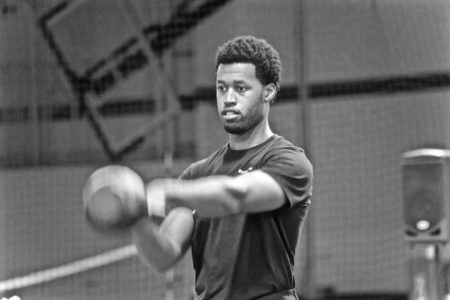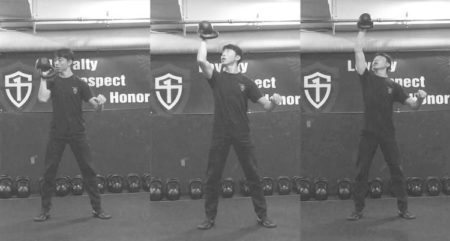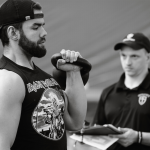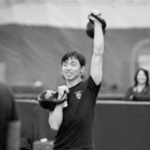The offer of a shortcut always seems tempting. But life experiences quickly teach us that they usually come with a catch—or simply don’t deliver the promised results. However, if you’ve ever struggled with kettlebells landing heavily during the clean, high pull or snatch, here is one shortcut that will save you time, effort, and sore joints. Is there a catch? Yes, but one you’ll enjoy.
One of the reasons ballistic kettlebell movements—like the swing, clean, and snatch—deliver a lot of bang-for-the-buck is because they demand a lot of force production, even with relatively light loads.
At the endpoints of these movements, given the acceleration and mass of the kettlebell, a massive amount of deceleration is required to control the landing. That work is shared mainly between the muscles of the spine, shoulders, and hips. When repetitive forces from dynamic movements are not efficiently handled, these joints can be prone to injury.
This highlights the importance of grooving solid technique and good control throughout the manoeuvres for safety and performance.
May the Force Be With You
Forces can either be an elixir for our joints and muscles—making us stronger and more resilient as we adapt to them—or a poison when not dosed correctly. If you recall my previous article, The SFG Clock, you already know changing the direction of the bell can turn discomfort into strength.
Recently, I met a new student who had trained with kettlebells for just over a year. He described suffering from shoulder pain every morning following his kettlebell training. After checking his clean technique, I found the likely cause of the problem.
He was not, as we call it in StrongFirst, ‘taming the arc’—meaning he could not control the kettlebell’s path on the way up or down. Consequently, the excess torque, generated by the kettlebell’s inefficient path, punished his shoulders and contributed to his pain.
In its trajectory from the clean or snatch’s hike to its landing, an uncontrolled kettlebell will travel in a wide, round arc away from the body as you stand up. The further away the kettlebell travels on its journey, the further and faster it has to come back towards your body as you reach the top position. This is what commonly produces uncomfortable jarring as the kettlebell lands on the shoulder at the top of the clean, or the forearm at the top of the snatch.

The same is true during the reverse of these movements as we descend from their top positions. The further away the kettlebell arcs from your body, the more your shoulder must work not to disconnect from your torso (unpack), and the more the kettlebell pulls you forward as you hinge. This can lead to your torso moving forward instead of your hips reaching back, to your bodyweight shifting onto your toes instead of staying planted on your heels, and to the kettlebell dropping below the knees in the backswing. The big posterior chain muscles are no longer in an optimal mechanical position to absorb the force of the bell as it swings between the legs, leaving the lower back to do the job unaided.
Controlling the path of the kettlebell in ballistic movements is, therefore, important both on the way up and return back down.
Taming the arc is one of the most challenging aspects of kettlebell lifting for many, but it is a necessary skill to master before you can claim proficiency. Not only does it protect the spine and prevent sudden jarring at either end of the movement, but it also shortens the distance the bell travels.
You may not think that matters too much until you’re undertaking something like the Tactical Strength Challenge or SFG snatch test. To perform as many snatch reps as we can over a given time, we need to reduce the distance the kettlebell is moving without compromising technique. A little extra efficiency in each rep adds up to a lot of time and energy saved over 5 minutes.
The Key to Taming the Arc
Now that we understand the theory let’s look at how we put it into practice. As I previously wrote in The SFG Clock, for both the clean and the snatch, the kettlebell starts at the 5 o’clock position before we hike it back to 8 o’clock.

The key to taming the arc in the clean is to strike your elbow towards 9 o’clock as you stand up from the hike, before finishing with the elbow pointing down at 6 o’clock. This elbow strike helps to connect your shoulder and to reduce the distance of the bell from your body on the way up.
The only difference on the way down is the amount of force required. As gravity is assisting the bell’s descent, it will take less effort to jab the elbow backward.
In either direction, you can visualize your bent elbow hitting the wall behind you at waist height.
And Now for the Catch
If that mental cue isn’t enough, here is a drill with three variations for different skills: the clean, the high pull, and the snatch. This is one of my favorite drills, not only because it is extremely informative for my students, but also because it is fun.

For obvious reasons, this is a drill to practice in safe surroundings and using a relatively light weight. If your floor isn’t suitably cushioned, practicing outdoors on flat grass is ideal. Remember: if you drop the bell, fast feet are happy feet.
We are not catching the bell here as a circus trick. The brain has a good survival incentive not to swing the bell wildly away from the body, only to have it swing back in at speed. Catching the bell softly requires the shallow, controlled arc we want for these ballistic lifts. Immediately follow each soft catch with a regular repetition to reinforce the desired pattern.
Tame the Clean
Follow the SFG Clock pattern for the clean: start the bell at 5 o’clock, then hike back to 8 o’clock. As you drive from your hips to stand, remember to jab your elbow towards 9 o’clock to tame the arc, and aim to softly catch the bell at your shoulder, with your elbow pointing to 6 o’clock.
Let the bell drop straight down and catch it close to the body on its descent. Done correctly, the catch on the way down will also be soft and smooth.
To progress, repeat multiple pairs of TC to Clean.
Tame the High Pull
The high pull is itself a useful drill to help us get from the kettlebell clean, which finishes with the bell racked at the shoulder, to the snatch, which finishes with the bell in an overhead lockout. If the student is swinging the bell away during the high pull, this variation of the catch drill will teach them to keep it close.
All the same rules apply as for the clean, except our catching point is now at head height. You will see in the video, even though the bell travels higher, it is still over my feet when caught.
Similarly, the catch on the descent happens with a bent arm and close to the body.
To progress, repeat multiple pairs of THP to High Pull.
Tame the Snatch
If you have mastered taming the high pull, progressing to the full snatch is a small step. Again, all our rules for the snatch from the SFG Clock apply, except the aim is to softly catch the bell with the arm extended overhead.
The bell barely drops before being re-caught softly on the way down.
To progress, repeat multiple pairs of TS to Snatch.
The SFG Clock taught us the correct destinations for the bell in the ballistic lifts. Now, instead of driving the long way round to get there, you can tame the arc and take a shortcut your joints will thank you for.
Taming the arc means maximizing both effectiveness and performance while minimizing stress on our joints. Less stress, more performance, that is our goal.






Excellent article. Used these drills this very week after studying. Great response from many of my Kettlebell students
“Forces can either be an elixir for our joints and muscles—making us stronger and more resilient as we adapt to them—or a poison when not dosed correctly.”
Couldn’t agree more with this statement. Great article!
Excellent sir thank you